The word for this week’s outing is “crescendo.” Barred from the Parker River National Wildlife Refuge by the annual hunt to cull the deer herd, our group headed up the coast to the north, beginning at Salisbury Beach State Reservation. The Wild Turkey herd of Ferry Road loitered in a driveway. An immature Red-tailed Hawk perched in a spreading tree along the state reservation entrance road. Real action started at the boat ramp, where Red-breasted Mergansers, a young male Surf Scoter, Red-throated Loons, Common Eiders, and at least one Common Loon foraged in around the mouth of Black Creek. A Northern Harrier flew so far away across the marsh that only one of us saw it. We found one Common Goldeneye out on the wide river, a very low number for this time of year. Long-tailed Ducks jetted about in singles and pairs. Many of us noticed, as the temperature dropped and the wind rose, that we had not dressed properly for a cold, gray, and windy day.
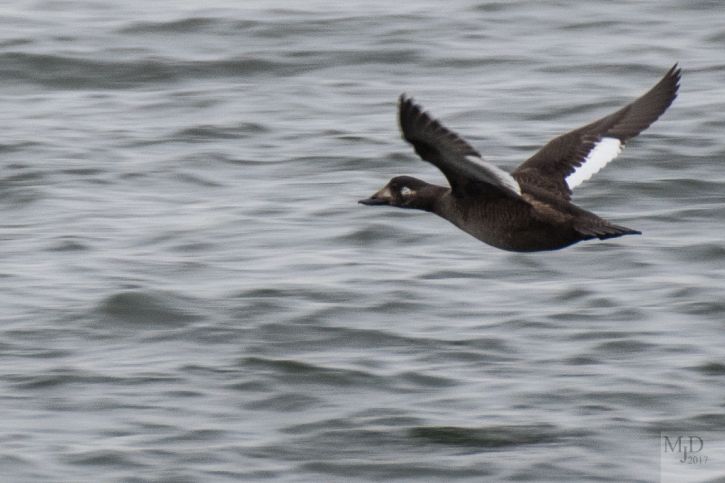
White-winged Scoter – Mike Densmore
At parking lot #1, at the foot of the north jetty, we found White-winged Scoters, some loons, and lots more eiders scattered around. A big flock of sandpipers nestled in the rocks almost at the end of the jetty. After a long period of staring through scopes while toughing out the wind and enduring various speculations and name-calling (of birds), Dave Weaver and I decided it was time to put our heads together We agreed that those sandpipers looked most like Dunlin, even though they should have been Purple Sandpipers. See the list below for our final decision. While the parking lots at Salisbury had good contingents of roosting gulls of our three common species, there were none of the species we had gone over in the lobby as quiz birds for the week (gulls with light wing tips). One must pause with respect, however, for birds that find comfort sitting in the middle of a parking lot in a stiff north wind. Once the frigid temperatures arrive, we’ll find gulls still hunkered on the freezing asphalt, a real demonstration of survival chops.
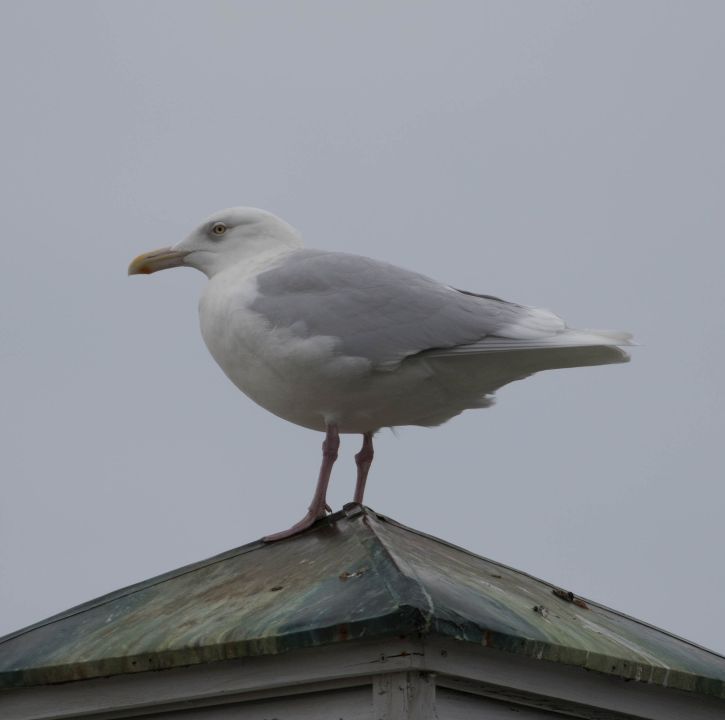
Glaucous Gull at Seabrook- David Moon
A birding trip leader worries when not very much happens at the first two stops: “uh oh, maybe this will be one of those.” But we must keep an open heart and mind, and remember that things can change while out and about. With that attitude, we headed north and scanned in vain all the dull surfaces between the state reservation and a special spot in Seabrook, where we were hoping for the easy gull “get.” Indeed, we found the loyal Glaucous Gull — one of those gulls with light wing tips – in its customary perch on the bathhouse cupola on the inland side of the road in Seabrook. According to Steve Mirick, this gull has been perching there each winter since November 2008, when Steve identified it as a 2nd- or 3rd-year bird, making it now 10 or 11 years old. What fun, an uncommon species that was not far out on some mud flat! That was the break we needed for the floodgates of birding to open!

Common Loons – John Linn
At the inlet of Hampton Harbor, the light improved, and the water was a fascinating intersection of waves and current. Among the many eiders, scoters, and loons, we found a Red-necked Grebe. On the north jetty navigational marker, a young Great Cormorant sat showing us its whitish belly and gray bill. Up until that moment, not one little ground bird had flitted or hopped from one bare patch of dead grass to another, and even here we saw none. But the abundant birds in the choppy water, spiced by two less-common ones, had us feeling buoyant enough to zip over to Cherry Hill Reservoir for the morning’s conclusion.
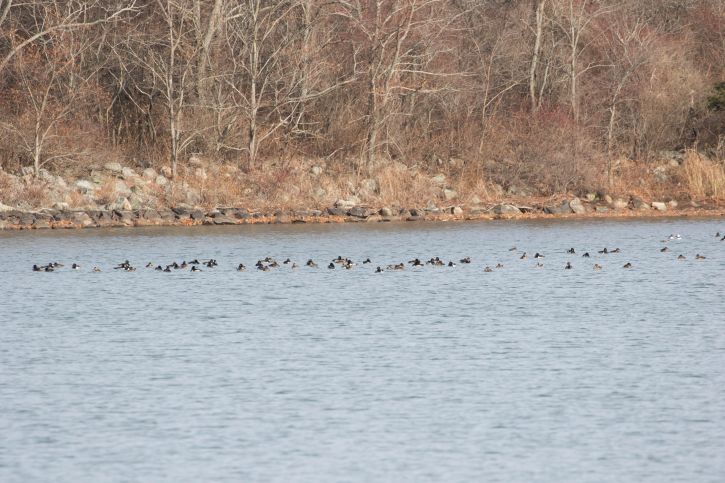
Waterfowl on Cherry Hill Reservoir – David Moon
We were pushing the boundaries of time in adding Cherry Hill to the trip, so it seemed important to find a bunch of birds instead of an empty lake. Pulling up to the lookout, we could see big flocks of multiple species arrayed on the surface, and right there in front of us were four Hooded Mergansers. Our arrival precipitated movement of a great group of Ring-necked Ducks from the north shore, in which we eventually found a few Buffleheads and a pair of Lesser Scaup. Ruddy Ducks were everywhere, scattered singly and in pairs as well as in large rafts. At the south end of the lake, a long line of 54 Common Mergansers stretched across the water, as they often do.
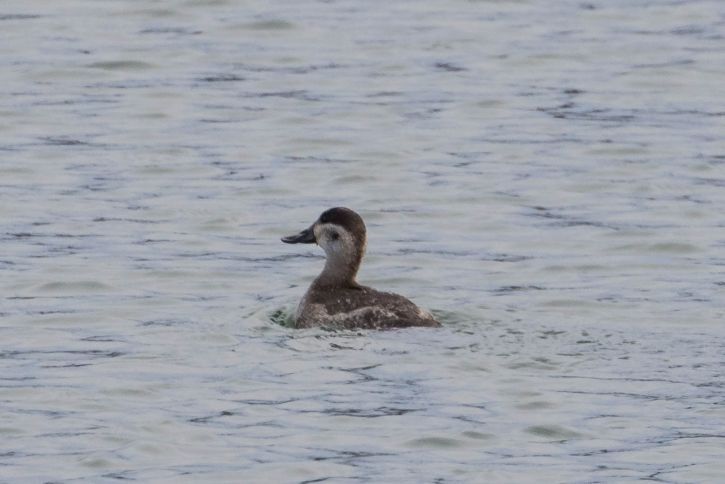
Ruddy Duck on Cherry Hill Reservoir – David Moon
On the way to the reservoir, Susan Balser had speculated that we might see a Bald Eagle. Not only did an eagle soar over us in a sky that had turned clear, but a Red-tailed Hawk took the rare opportunity to be the smaller bird harassing the larger predator, and thus we witnessed one of those jaw-dropping spectacles of the birding world. Wednesday Morning Birding sometimes ends with a crescendo, where a multitude of birds shows us how powerful and extraordinary our living world is, and why we can never fail to celebrate and protect nature. This was one of those outings, and all of us went on with our week with spirits renewed.
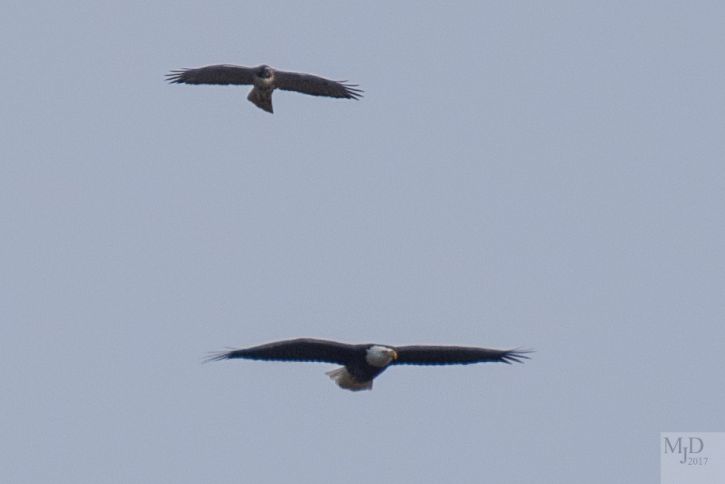
Bald Eagle and Red-tailed Hawk – Mike Densmore

Bald Eagle attacked by Red-tailed Hawk – Mike Densmore
Our List:
Canada Goose – various.
Mute Swan (3) – Upper Artichoke Reservoir.
American Black Duck – common; Salisbury.
Mallard (~ 15) – Upper Artichoke Reservoir.
Ring-necked Duck (~ 50) – Cherry Hill Reservoir.
Lesser Scaup (2) – pr., Cherry Hill Reservoir.
Common Eider – common; Salisbury & Hampton Beach.
Surf Scoter (2) – Salisbury.
White-winged Scoter (~ 25) – Salisbury & Hampton Beach.
Long-tailed Duck (~ 15) – Salisbury.
Bufflehead (6) – 1, Salisbury; 5, Cherry Hill Reservoir.
Common Goldeneye (1) – drake; Salisbury.
Hooded Merganser (4) – 2 pr., Cherry Hill Reservoir.
Common Merganser (~ 60) – mostly hens; Cherry Hill Reservoir.
Red-breasted Merganser – common; Salisbury & Hampton Beach.
Ruddy Duck (~ 65) – Cherry Hill Reservoir.
Wild Turkey (~ 12) – Ferry Road en route Salisbury.
Red-throated Loon (~ 10) – Salisbury & Hampton Beach.
Common Loon (~ 8) – Salisbury & Hampton Beach.
Red-necked Grebe (1) – Hampton Beach.
Great Cormorant (1) – Hampton Beach.
Great Blue Heron (1) – Joppa Flats.
Bald Eagle (1) – ad.; Cherry Hill Reservoir.
Northern Harrier (1) – Salisbury.
Cooper’s Hawk (1) – Seabrook.
Red-tailed Hawk (2) – 1 juv., Salisbury; 1 ad. harassing Bald Eagle.
Dunlin (~ 35) – Salisbury jetty.
Ring-billed Gull (~ 15) – Salisbury.
Herring Gull
GLAUCOUS GULL (1) – presumably returning ad., Seabrook, atop bath house cupola on Rt 1, just south of Hampton Harbor Inlet bridge.
Great Black-backed Gull (~ 20) – Salisbury; mostly Hampton Beach.
Rock Pigeon
Mourning Dove
Belted Kingfisher (1) – Cherry Hill Reservoir.
Downy Woodpecker (1) – W. Newbury.
Blue Jay (5) – various.
American Crow (~ 10) – various.
American Robin (1)
Northern Mockingbird (2) – Seabrook.
European Starling
Dark-eyed Junco (1) – Seabrook.
Northern Cardinal (1)
American Goldfinch (2) – Cherry Hill Reservoir.
House Sparrow – Cherry Hill Reservoir.


I love to see the photos you post. Hope to join you one of these days!